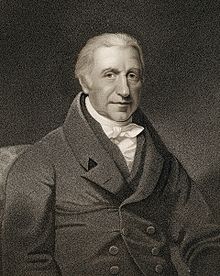William Babington (physician)

William Babington FRS FGS (21 May 1756 – 29 April 1833) was a British physician and mineralogist.
Life and work
Babington was physician to Guy's Hospital from 1795 to 1811. He was a founder member of the Geological Society of London and served as president from 1822 to 1824. He was elected as a Fellow of the Royal Society in 1805.
He was the curator for the enormous mineral collection of John Stuart, 3rd Earl of Bute. When Bute died in 1792, Babington bought the collection. The mineral Babingtonite is named after him.
William and Martha Elizabeth Babington were married before 1794, and had four sons and four daughters between 1794 and 1810. Babington died on 29 April 1833 and was buried at St. Mary Aldermanbury in London.[1] He left a son, Benjamin Guy Babington,[2] also physician to Guy's Hospital, and a daughter, Martha, who married the physician Richard Bright.[3]
A statue of Babington by William Behnes (1795–1864) is in St. Paul's Cathedral in London.
Selected publications
- "A Systematic Arrangement of Minerals, founded on the joint consideration of their chemical, physical and external characters; reduced to the form of tables." (1796) London, T. Cox.
- "A New System of Mineralogy, in the form of a Catalogue, after the manner of Baron Born’s Systematic Catalogue of the collection of fossils of Mlle Éléonore de Raab". (1799) London, T. Bensley.
References
- ^ Munk, William (1878). The Roll of the Royal College of Physicians of London. London: Royal College of Physicians. pp. 451–455.
{{cite book}}:|access-date=requires|url=(help) - ^ ODNB article by J. F. Payne, ‘Babington, Benjamin Guy (1794–1866)’, rev. Michael Bevan, Oxford Dictionary of National Biography, Oxford University Press, 2004, accessed 10 March 2008.
- ^ ODNB article by J. F. Payne, ‘Babington, William (1756–1833)’, rev. John C. Thackray, Oxford Dictionary of National Biography, Oxford University Press, 2004, accessed 10 March 2008
Further reading
- Munk, William (1878). The Roll of the Royal College of Physicians of London. London: Royal College of Physicians. pp. 451–455. Retrieved 11 March 2008.
- Smyth, George Lewis (1843). Biographical Illustrations of St. Paul's Cathedral. London: Whittaker and Company. pp. 93–94. Retrieved 11 March 2008.
External links
 Webb, Alfred (1878). A Compendium of Irish Biography. Dublin: M. H. Gill & son.
Webb, Alfred (1878). A Compendium of Irish Biography. Dublin: M. H. Gill & son. {{cite encyclopedia}}: Missing or empty|title=(help); Unknown parameter|subpage=ignored (help)- Babingtonite
- King's College London Archive Holdings for Babington.
